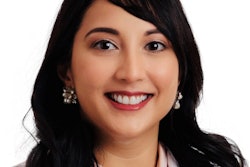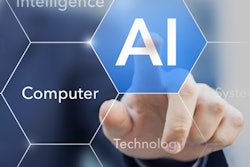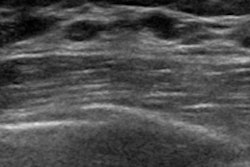
Using artificial intelligence (AI) to analyze breast ultrasound lesions reduced interpretation time by 49% at a healthcare center in Missouri. The software is particularly helpful for lesions classified as BI-RADS 2, 3, and 4A, attendees of the Society for Imaging Informatics in Medicine's (SIIM) virtual meeting learned on June 24.
For almost a year, the women's imaging department at Liberty Hospital in Liberty, MO, has used AI software developer Koios Medical's DS breast tool. Image data passes from the ultrasound scanner to the AI software server and then back to the ultrasound scanner as well as the radiologist's workstation. With the click of a button, a region of interest is analyzed within seconds and the AI software decides whether the lesion is suspicious or not and suggests a BI-RADS classification.
"I am a fellowship-trained breast imager," said Dr. Amy Patel, medical director at Liberty Hospital and a partner at Alliance Radiology. "This is all I do, read breast images, and I even have situations where I'm just not sure [what BI-RADS classification to use]. So [the AI tool] could help any radiologist of any practice type, whether you're a general radiologist reading breast images, or you're a dedicated breast imaging specialist."
In general, adding in this clinical decision-support tool reduces interpretation time by a range of 10-120 seconds because radiologists no longer have to deliberate as much when classifying lesions, particularly BI-RADS 2, 3, and 4A lesions. At Liberty Hospital specifically, the group is saving between 20 and 30 seconds, which may not sound like much, but it is, according to Patel.
"It's very amazing because these seconds, as we all know, add up to minutes, minutes to hours," she said. "We see a value in that."
Reducing mammogram interpretation time also means an increase in diagnostic case throughput volume because radiologists are able to read more cases in a day. Plus, using the DS tool has resulted in other benefits: The group noticed a 14% drop in the false-positive rate, fewer false negatives, fewer unnecessary biopsies, and a general increase in diagnostic confidence.
Especially with the lesions that radiologists are unsure about, Koios' DS breast software offers a welcome second opinion, Patel said. The radiologist is the one driving the clinical decision-making, but AI can provide extra diagnostic confidence and peace of mind not only for the radiologist but also for the patient and everyone involved because they know there's extra support in making diagnoses.
"Radiology burnout is so real," Patel said. "I do think that whenever you have a complicated case, regardless of any subspecialty of radiology, there is stress behind that. I think in breast imaging, we oftentimes do feel stress because we don't want to miss a breast cancer. But at the same time, we don't want to recommend an unnecessary biopsy, so all of that stress can really compound itself and can lead to burnout. I can honestly say that with using this tool on such a consistent basis, it has really reduced the stress that's associated with these cases."



















